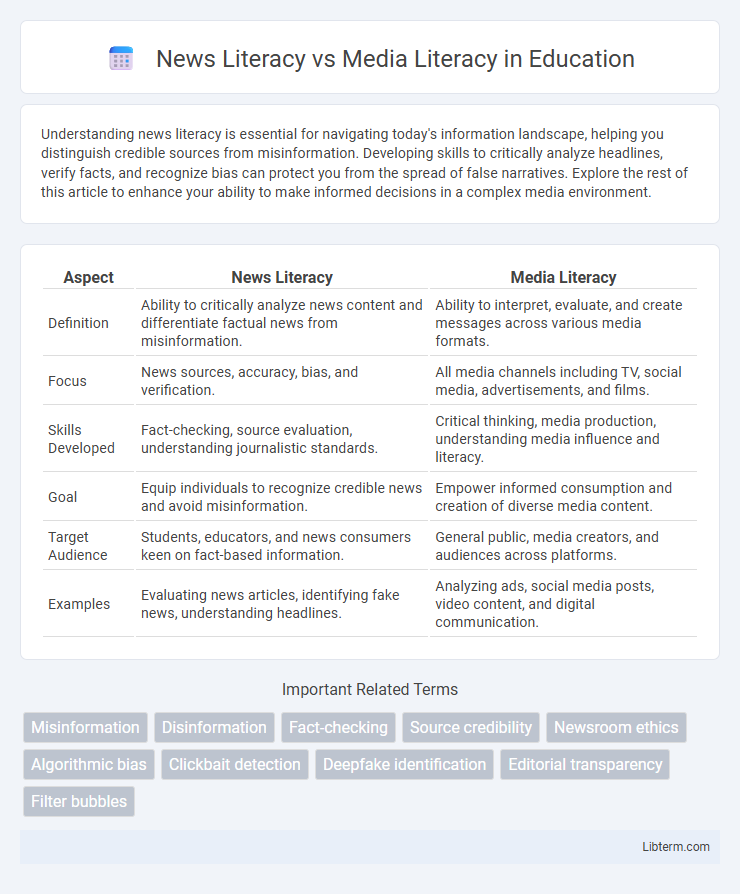Understanding news literacy is essential for navigating today's information landscape, helping you distinguish credible sources from misinformation. Developing skills to critically analyze headlines, verify facts, and recognize bias can protect you from the spread of false narratives. Explore the rest of this article to enhance your ability to make informed decisions in a complex media environment.
Table of Comparison
| Aspect | News Literacy | Media Literacy |
|---|---|---|
| Definition | Ability to critically analyze news content and differentiate factual news from misinformation. | Ability to interpret, evaluate, and create messages across various media formats. |
| Focus | News sources, accuracy, bias, and verification. | All media channels including TV, social media, advertisements, and films. |
| Skills Developed | Fact-checking, source evaluation, understanding journalistic standards. | Critical thinking, media production, understanding media influence and literacy. |
| Goal | Equip individuals to recognize credible news and avoid misinformation. | Empower informed consumption and creation of diverse media content. |
| Target Audience | Students, educators, and news consumers keen on fact-based information. | General public, media creators, and audiences across platforms. |
| Examples | Evaluating news articles, identifying fake news, understanding headlines. | Analyzing ads, social media posts, video content, and digital communication. |
Introduction to News Literacy and Media Literacy
News literacy involves the ability to critically evaluate news sources and distinguish credible information from misinformation, emphasizing understanding journalistic processes and verifying facts. Media literacy encompasses a broader skill set including analyzing various media formats, recognizing bias, and understanding media production and intent across digital, print, and broadcast platforms. Both fields aim to empower individuals to navigate the complex information landscape with critical thinking and informed judgment.
Defining News Literacy
News literacy involves the ability to critically evaluate news sources, verify facts, and distinguish between credible journalism and misinformation. It emphasizes understanding the production process of news, recognizing bias, and identifying the intent behind news content. This skill is essential for making informed decisions in a landscape filled with diverse media channels and rapid information dissemination.
Understanding Media Literacy
Understanding media literacy involves recognizing the skills needed to critically analyze different types of media content, including news, advertisements, and social media posts. Media literacy encompasses the ability to evaluate the credibility of sources, identify biases, and differentiate between fact and opinion across various platforms. Developing these competencies enhances an individual's capacity to navigate the complex media landscape and make informed decisions based on accurate information.
Key Differences between News Literacy and Media Literacy
News literacy specifically emphasizes the ability to critically evaluate news sources, discern factual information from misinformation, and understand journalistic standards. Media literacy encompasses a broader scope, including the analysis of diverse media forms such as television, social media, advertising, and entertainment content, focusing on understanding media production, purpose, and influence. The key difference lies in news literacy's targeted focus on news consumption and verification, while media literacy addresses a wide array of media messages and their impact on audience perception.
Importance of News Literacy in the Digital Age
News literacy is crucial in the digital age as it empowers individuals to critically evaluate the accuracy and credibility of information amid the overwhelming volume of online content. It enables consumers to distinguish between factual news, misinformation, and disinformation, protecting against the manipulation prevalent on social media platforms. Developing strong news literacy skills supports informed decision-making and fosters a resilient, well-informed society.
The Role of Media Literacy in Modern Society
Media literacy plays a crucial role in modern society by empowering individuals to critically analyze, evaluate, and create media content across diverse platforms, enhancing informed decision-making. It fosters the development of skills to identify misinformation, understand media bias, and interpret the influence of digital algorithms on news consumption. This competence is essential for maintaining democratic engagement and promoting responsible citizenship in an era dominated by rapid information exchange and social media proliferation.
Common Skills Developed through News and Media Literacy
News literacy and media literacy both develop critical thinking skills essential for evaluating sources and distinguishing credible information from misinformation. They enhance the ability to analyze bias, understand perspectives, and recognize the intent behind content across various platforms. These skills empower individuals to navigate digital environments responsibly and make informed decisions based on accurate and reliable information.
Challenges in Teaching News and Media Literacy
Teaching news and media literacy faces challenges such as combating misinformation and helping students critically analyze diverse sources amid the rise of deepfakes and algorithm-driven content. Educators must address varying digital skills and skepticism levels while creating engaging curricula that promote critical thinking and fact-checking abilities. Limited access to reliable tools and evolving media landscapes further complicate consistent instruction and assessment in these literacies.
Strategies for Enhancing News and Media Literacy
Effective strategies for enhancing news and media literacy include critical evaluation of news sources, cross-referencing facts, and understanding media bias to discern credibility. Incorporating digital tools and educational programs can improve users' ability to identify misinformation and navigate complex media landscapes. Promoting active engagement and reflective thinking sharpens analytical skills essential for interpreting diverse media messages accurately.
The Future of News and Media Literacy Education
The future of news literacy and media literacy education hinges on equipping learners with critical skills to navigate misinformation and deepfakes in an increasingly digital media landscape. Integrating artificial intelligence tools and interactive platforms enhances the ability to discern credible news sources from biased or false content. Emphasizing collaboration between educators, technologists, and journalists fosters adaptive curricula that address evolving challenges in news consumption and media interpretation.
News Literacy Infographic

 libterm.com
libterm.com